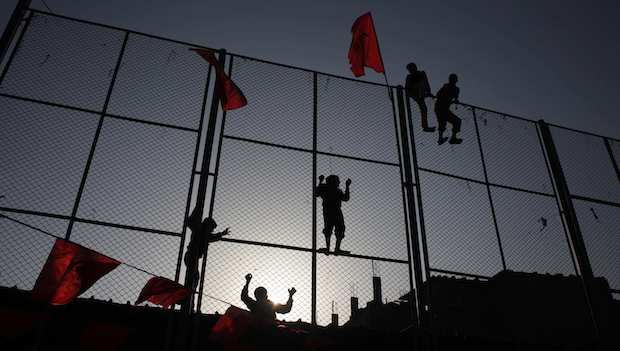There are cities, states and whole regions that are fated to never stay out of the news for too long—and I don’t mean local, everyday news, but important, sometimes earth-shattering news. These are the places with conflicts that have no hope of being resolved anytime soon.
Gaza is one of those hotspots. Earlier this month, on March 12, Israeli Foreign Minister Avigdor Lieberman called for the “reoccupation” of Gaza in retaliation against Palestinian Islamic Jihad firing a number of rockets into Israeli territory. Speaking on Israel’s Channel 2 television, Lieberman said: “Following an attack like this—a barrage of more than 50 rockets—there is no alternative to full reoccupation of the entire Gaza Strip.”
That was not the first time an Israeli official had flapped his mouth about the threat of reoccupation. But still, we must ask the Palestinian leadership a question: was Lieberman’s statement nothing more than meaningless, empty chin-wagging? Probably most people would respond with an easy “yes,” but we must take into account the rising tensions on the international stage, particularly after Russia officially annexed Crimea. In this global political climate, the rockets of the Al-Quds Brigade could become the excuse Tel Aviv needs—the excuse it has long awaited—to prove that this time, Lieberman’s threat was not merely for local consumption.
The first international problem that may have a bearing on the Gaza situation is clearly the growing tension between Russia and the West, and the looming possibility that crisis could become a military one. But we must also take a close look at the events in Syria and their repercussions for Lebanon, Iraq and Jordan, as well as the domestic situation in Egypt, to understand that international circumstances may allow Israel to reoccupy Palestinian territory if it so desires. If this were to happen, the first and last actions on the international stage would probably be nothing more than a denunciation here and a condemnation there.
It is more painful to say, clearly and frankly, that the Palestinians have failed to preserve the independence they achieved. It is difficult to acknowledge that the Palestinian side did not know how to build on the land it acquired or how to keep working to achieve more. In fact, Palestinian leaders showed their worst side as their public face, letting the world watch while they carried on absurd arguments about things such as the allocation of ministerial portfolios and who exactly was responsible for security. This quickly evolved into what we saw in the summer of 2006—a year after the Israeli withdrawal from Gaza—when there were gunfights, arrests and divisions. The youth truly believed they had built a state, and they were attacking each other to take control of that state.
In reality, the belief in this illusory “state” and the spread of administrative corruption and financial disarray was present long before 2006. Indeed, it dates back to the Palestinian Authority’s return to Gaza after it had been headquartered in Tunisia.
As I write this article, there is a copy of the front page of this newspaper from November 2, 1996, hanging in a frame above my desk. On the front page is an image of a child who looks like a victim of the famine in the Horn of Africa—but he is from Gaza. The caption says he weighs three kilograms less than he should. It was one of the most striking pictures that accompanied a series of investigative articles I wrote while on assignment in the Strip. On another, the caption reads: “Children live on bread and tea . . . Newborns are dying of malnutrition.” One of the headlines in that series was: “Young men plead for jobs as depression spreads like wildfire.” A key reason for that terrible situation was that Israel had closed its border crossings to workers residing in the Gaza Strip.
At the same time, however, there was a sudden and unusual prosperity among the minority in Gaza who were close to the ruling elite following the return of Palestinian officials from Tunisia. It has become clear that Gaza is paying for the weaknesses of the administrative and foreign policies implemented by everyone who has led the Gaza Strip from the Oslo Accords of the mid-1990s until today. How much longer will this situation continue?
The Gaza Strip is being suffocated by its 1.5 million inhabitants, who must squeeze into an area unfit to host even a quarter of that number. When will the time be right for the Gaza Strip and its people to breathe? Are they destined to have their fate remain in the hands of others—of those responsible for the missile attacks and closed border crossings and those preoccupied with negotiating a framework to guide negotiations?
What is this? Who is trying to sell what, and to whom? In theory, this is an open market where the customer is always right, but most people in this part of the world have grown sick and tired of the merchants and their false merchandise. Their situation is clear and simple: they want a good life, as is their right and as other human beings want. They want even a quarter of the rights and amenities enjoyed by their neighbors in the Gush Katif Israeli settlement in Gaza, where electricity and water flow without interruption while the Palestinians of Gaza drown in thirst and darkness.
I know others have made similar calls before, but I will repeat them, addressing the entire world and, most importantly, the Palestinian leaders who are at each other’s throats. Please, let Gaza breathe. What happens in Gaza will also happen to all Palestinian cities and villages until the long-awaited dream of an independent state has been achieved.
